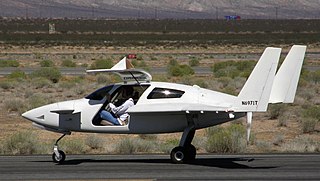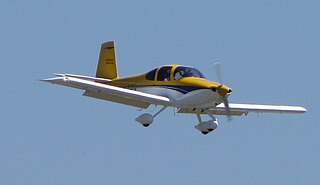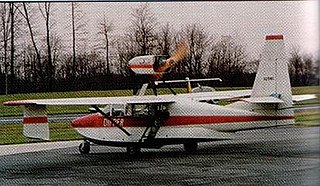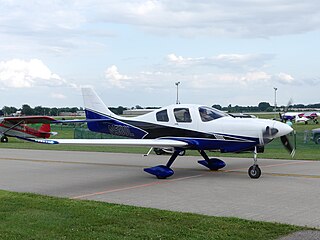
The Rutan Model 61 Long-EZ is a tandem 2-seater homebuilt aircraft designed by Burt Rutan's Rutan Aircraft Factory. The Long-EZ has a canard layout, a swept wing with wingtip rudders, and a pusher engine and propeller. The tricycle landing gear has fixed main wheels with streamlined spats and a retractable nosewheel. Its predecessor was the VariEze, plans for which were first available to homebuilders in 1976. The prototype Long-EZ, N79RA, first flew on June 12, 1979.

The Rutan VariEze is a composite, canard aircraft designed by Burt Rutan. It is a high-performance homebuilt aircraft, hundreds of which have been constructed. The design later evolved into the Long-EZ and other, larger cabin canard aircraft. The VariEze is notable for popularizing the canard configuration and moldless glass cloth composite construction for homebuilt aircraft.

The Rutan Model 40 Defiant is a four-seat, twin-engine homebuilt aircraft with the engines in a push-pull configuration. It was designed by aerospace engineer Burt Rutan for the Rutan Aircraft Factory.

The Cozy Mark IV is a 4-seat, single engine, homebuilt light aircraft designed by Nat Puffer, with parts and plans supplied by Aircraft Spruce & Specialty Co. The aircraft is built from plans using basic raw materials. It is not a kit aircraft, though many small parts are available prefabricated. The Cozy is similar in design and construction to the 2-seat Rutan Long-EZ, from which it is derived, with approval from Burt Rutan.

The Berkut 360 is a tandem-seating, two-seat homebuilt canard aircraft with pusher configuration and retractable landing gear, built primarily of carbon fiber and fiberglass.

The Velocity Model 173 SE (Standard Elite) is an entry level canard pusher aircraft from Velocity Aircraft. The four seat, rear engine aircraft may be powered by a 160 hp (120 kW) Lycoming IO-320 or a 200 hp (150 kW) Lycoming IO-360 engine.

The Velocity XL is an American amateur-built aircraft, produced by Velocity, Inc. It is an enlarged version of their Velocity SE canard pusher design.

The Van's Aircraft RV-10 is a four-seat, single-engine, low-wing homebuilt airplane sold in kit form by Van's Aircraft. It is the first four-seat airplane in the popular RV series. The RV-10 first flew on 29 May 2003, and the first kit parts were delivered to a customer in September 2003.

The Wassmer WA-51 Pacific is a French four-seat cabin monoplane designed and built by Société Wassmer. Different-powered variants include the Wassmer WA-52 Europa and the Wassmer WA-54 Atlantic. It was the world's first composite material-built aircraft.

The Beecraft Queen Bee was an American V-tailed four-seat cabin monoplane, designed and built by Bee Aviation Associates (Beecraft).

The Rutan Model 77 Solitaire is an American, single seat, canard, mid-wing motor glider that was developed by Burt Rutan in response to the 1982 Sailplane Homebuilders Association Design Contest for a homebuilt glider. It first flew in 1982. The Solitaire was declared the winner of the contest and its unusual layout attracted a great deal of attention. For a time in the 1980s the aircraft was available as plans and as a kit.
The Schreder HP-22 was an American mid-wing, amphibious flying boat, cruciform tailed, two seat motor glider project that was designed by Richard Schreder. None were ever completed or flown.
The Cameron P-51G is an American two-seat turboprop representation of the 1940s North American P-51 Mustang, designed and built by Cameron & Sons Aircraft of Coeur d'Alene, Idaho for sale as completed aircraft or kits for amateur construction.
The AeroCad AeroCanard is a family of American amateur-built aircraft, designed and produced by AeroCad of Florissant, Missouri. The aircraft is supplied as a kit for amateur construction.

The Quickie Q2 or Q2 is a two-seat version of the unique Rutan Quickie, produced in kit form by the Quickie Aircraft Corporation founded by Tom Jewett and Gene Sheehan. Canadian Garry LeGare was involved in the design.

The Collins Dipper was an American homebuilt flying boat that was designed and produced by Collins Aero of Chadds Ford, Pennsylvania and first flown in 1982. The aircraft was supplied in the form of plans for amateur construction. Only one was built and none remain registered.
The Mirage Marathon is an American homebuilt aircraft, designed and produced by Mirage Aircraft Corporation of Prescott Valley, Arizona. The aircraft is supplied in the form of plans for amateur construction, with materials kits supplied by Aircraft Spruce & Specialty Co. and Wicks Aircraft Supply as well as some specialized parts supplied by the manufacturer.
The Parrish Dart is an American canard-configuration homebuilt aircraft that was designed by Jimmy R. Parrish and produced by Parrish Aircraft Xperimental, Inc. of Plantation, Florida. It first flew in the Autumn of 1995. When it was available the aircraft was supplied in the form of plans for amateur construction.

The Lancair Mako is an American amateur-built aircraft designed and produced by Lancair of Uvalde, Texas, introduced at AirVenture in 2017. The aircraft was first flown on 18 July 2017 and is supplied as a kit for amateur construction. It is named after the shark.

The Lancair 200 and Lancair 235 are a family of American amateur-built aircraft that were designed by Lance Neibauer and produced by his company, Lancair of Redmond, Oregon. The Lancair 200 was initially called the Lancer 200, but the name was changed due to a naming conflict. It was first shown at AirVenture in Oshkosh, Wisconsin in July 1985. Now out of production, when it was available the aircraft was supplied as a kit, for amateur construction.
















